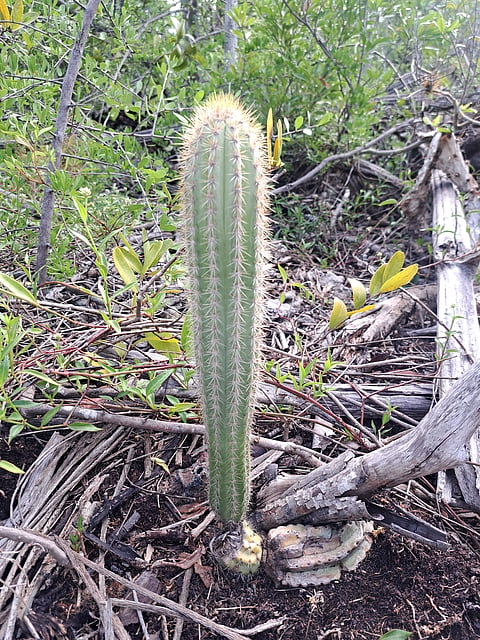

Rising sea levels, a growing threat linked to climate change, may have claimed its first victim in the United States — a unique cactus species. A new study suggests the Key Largo tree cactus, discovered roughly three decades ago in North America, was driven to extinction locally in 2023.
The cactus, known scientifically as Pilosocereus millspaughii, once thrived in a single population in Florida Keys, an island chain particularly vulnerable to the effects of sea-level rise and storm surge as much of its land sits less than 5 feet above sea level. Researchers believe rising sea levels inundated its habitat with saltwater, ultimately leading to its demise.
While the species can still be found on a few scattered islands in the Caribbean, including northern Cuba and parts of the Bahamas, the loss of the Key Largo population marks a significant milestone in the fight against climate change and its impact on biodiversity.
Between 1971 and 2022, the region’s average sea level rose by 4.09 millimetres every year, or 0.21 metres total, according to data. Rising sea levels, soil depletion from hurricanes and high tides and mammalian herbivory have all contributed to an increase in saltwater intrusion in the region, the paper stated.
“Unfortunately, the Key Largo tree cactus may be a bellwether for how other low-lying coastal plants will respond to climate change,” Jennifer Possley, director of regional conservation at Fairchild Tropical Botanic Garden and lead author of the study, said in a statement.
The paper documents the species’ collapse over the years. The cacti reportedly survived Hurricane Georges in 1998 and were not significantly impacted by a series of four hurricanes in 2005.
But things changed in 2015. The researchers counted only 60 live individuals during that annual monitoring event. This was a 50 per cent decline from the previous report in 2013.
Possley thinks this was due to worse storm surges in recent hurricanes. This, she added, could have been related to sea-level rise or storm intensity, the location of the eye of the storm, and the like.
While some species are known to migrate to higher elevations in response to climate change, this cactus population did not have the option. “They inhabit a small island of upland habitat, surrounded by mangrove forest, which has a wet, mucky substrate, and would not support this cactus‘ growth. The nearest suitable habitat was too far away for dispersal by fragmentation,” Possley told Down To Earth.
Herbivory most likely played a role in it too. Cacti, according to the researchers, store water reserves in their stems in order to survive long periods without rain. This, they added, makes them attractive to animals dealing with water scarcity.
Since the year 2000, 19 named hurricanes have impacted the Florida Keys. In 2019, the region witnessed “king tides”, staying flooded for up to three months, the study noted. King tides are unusually high levels of water that can cause local tidal flooding.
The researchers observed an increase in saltwater flooding from king tides in the area.
“That limits the amount of freshwater available to small mammals and might be related to why the herbivores targeted this cactus, but we can’t say for sure,” study co-author James Lange, a research botanist at Fairchild, said in a statement.
By 2016, 28 rooted stems remained — a reduction of another 50 per cent from 2015.
By 2021, the team found only six ailing fragments, which were rescued for off-site cultivation. They returned to the site in July 2022 and again in July 2023 to search for any survivors that were missed in the previous rescue operations.
The team found no healthy material in 2022. However, in the following year, they saw a small, rooted fragment that was once in poor condition had re-grown to approximately 35 cm in height.
The team rescued this individual as well. “It was clear that the area will only continue to succumb to sea-level rise,” they wrote in the paper.
The year 2023 witnessed continued soil erosion in higher-elevation areas. Mangroves and salt-tolerant vegetation also began to increasingly encroach on the area.
“The collapse of the Key Largo tree cactus was likely caused by the confluence of storm surges, sea-level rise and the 2015 herbivory event,” the paper read. Other plant and animal species in the area are also at risk due to sea-level rise, the study warned.
The global sea level has risen by 103 mm since 1993, driven by water from melting ice sheets and glaciers, and the expansion of seawater as it warms, according to data from US agency National Aeronautics and Space Administration.
Florida Keys is not the only region at risk. A 2013 report from the US-based nonprofit, Center for Biological Diversity, found that 17 per cent — one in six — of the nation’s threatened and endangered species are at risk from rising sea levels. The top five species were Key deer, Loggerhead Sea turtle, Delmarva Peninsula fox squirrel, Western snowy and Hawaiian monk seal.